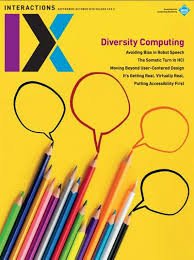OK folks... I've been waiting a few weeks to do this... Strap in!
Our cover story on DIVERSITY COMPUTING is now open access in @TheOfficialACM Interactions magazine - link below.
Here's a thread about this exciting new vision for tech #DivComp
delivery.acm.org/10.1145/325000…
Our cover story on DIVERSITY COMPUTING is now open access in @TheOfficialACM Interactions magazine - link below.
Here's a thread about this exciting new vision for tech #DivComp
delivery.acm.org/10.1145/325000…

First things first. The ideas in this paper and this htread came from a serious of thrilling and inventive conversations and writing-sessions with @theblub @cfrauenberger @MauriceMagnee @participha and others not on twitter - especially Juan Ye from @univofstandrews
And what were those conversations about, I hear you cry?
Well, they were mostly about how we could make computing a tool for a better society. We had a strong focus on #neurodiversity & #autism (obvs) but actually these ideas link to all sorts of diversity dimensions
#DivComp
Well, they were mostly about how we could make computing a tool for a better society. We had a strong focus on #neurodiversity & #autism (obvs) but actually these ideas link to all sorts of diversity dimensions
#DivComp
Our opening position is that people are biased.
Our biases are frequently useful, helping us respond quickly and efficiently to partial info. Which is why they're so hard to eliminate.
But biases can obviously take us into dark places: sexism, racism, ableism etc
#DivComp
Our biases are frequently useful, helping us respond quickly and efficiently to partial info. Which is why they're so hard to eliminate.
But biases can obviously take us into dark places: sexism, racism, ableism etc
#DivComp
Worringly, a lot of modern computing devices service to reinforce these biases.
Google searches reinforce gender stereotypes: indy100.com/article/google…
and racial prejudice:
washingtonpost.com/news/morning-m…
#DivComp
Google searches reinforce gender stereotypes: indy100.com/article/google…
and racial prejudice:
washingtonpost.com/news/morning-m…
#DivComp
Our so-called "social" networks are made up of individual devices, linked to each other in virtual space.
Interactions are easily controlled by mute or like buttons and the result is echo-chambers of shared thought:
google.co.uk/amp/s/qz.com/1…
#DivComp
Interactions are easily controlled by mute or like buttons and the result is echo-chambers of shared thought:
google.co.uk/amp/s/qz.com/1…
#DivComp
Meanwhile the YouTube "up next" algorithm has been accused of actively distorting public perceptions of the truth, with real world political consequences:
How YouTube algorithm works
theguardian.com/technology/201…
#DivComp
How YouTube algorithm works
theguardian.com/technology/201…
#DivComp
As a result of these sorts of phenomena, people like @fmanjoo have called for tech companies to wake up to their responsibilities:
nytimes.com/2017/12/13/tec…
#DivComp
nytimes.com/2017/12/13/tec…
#DivComp
One common way that tech companies attempt to address the problem of recapitulated bias in their products, is by trying to achieve diversity among their workforce.
Now, clearly diversity in teams is a Good Thing. You'll get no push back from us on that front, but...
#DivComp
Now, clearly diversity in teams is a Good Thing. You'll get no push back from us on that front, but...
#DivComp
...diversity in teams will not solve the problem of "Uniformity Computing"
That's because no team can "represent" diversity. Individual people are different from each other on multiple, fluctuating, complex dimensions that shift over time.
#DivComp
That's because no team can "represent" diversity. Individual people are different from each other on multiple, fluctuating, complex dimensions that shift over time.
#DivComp
People from minority groups frequently lament the impossibility of being expected to represent an entire community.
Representation matters. But it's not the whole solution.
#DivComp
Representation matters. But it's not the whole solution.
#DivComp
We believe "what is needed is the design of fundamentally new kinds of computing devices" that address the intractable problem of getting along with someone who is different from yourself.
We need mediating devices to help create and represent shared meaning.
That's #DivComp
We need mediating devices to help create and represent shared meaning.
That's #DivComp
The concept of #DivComp is grounded in @participha 's theory of participatory sense-making.
read more here: s3.amazonaws.com/academia.edu.d…
read more here: s3.amazonaws.com/academia.edu.d…
Our vision is that #DivComp devices will "invite and facilitate shared meaning-making between individuals and groups, embracing differences rather than eliminating them, without recourse to normative frameworks"
Some hallmarks of Diversity Computing machines...
Some hallmarks of Diversity Computing machines...
They will not belong to one person, but live in shared spaces
They will be an active part of a meaning-making process, contributing to & shaping the way two people understand each other
They will align with embodied cognition, providing physical cues & contributions
#DivComp
They will be an active part of a meaning-making process, contributing to & shaping the way two people understand each other
They will align with embodied cognition, providing physical cues & contributions
#DivComp
Here's a very simple example:
A meeting room with soft colour-change lighting
Devices auto-detect gender of people entering the room
The system monitors who is speaking and adjusts the lighting to reflect their gender
Harsh lighting appears if someone is too dominant
A meeting room with soft colour-change lighting
Devices auto-detect gender of people entering the room
The system monitors who is speaking and adjusts the lighting to reflect their gender
Harsh lighting appears if someone is too dominant
Over time, users of the room learn to redistribute their conversations so that no-one dominates & a balance is achieved.
Is this going to be hard? yep!
Do you have lots of questions about how this meeting room would work? sure!
(& that's just a very basic example)
#DivComp
Is this going to be hard? yep!
Do you have lots of questions about how this meeting room would work? sure!
(& that's just a very basic example)
#DivComp
What does it mean to "auto-detect gender"? what if the detection doesn't align with someone's personal identification? what if someone is mean't to be doing most of the talking? what if people don't want to be recorded?
All this is why #DivComp requires a complex framework
All this is why #DivComp requires a complex framework
We need to incorporate ethics, philosophy, art, design, engineering, computer science, psychology, sociology and more to realise this vision.
But if we can do it, we think #DivComp could genuinely make the world a better place as part of a bigger social justice agenda
But if we can do it, we think #DivComp could genuinely make the world a better place as part of a bigger social justice agenda
Please read the paper to find out more about #DivComp and follow my co-authors for their thoughts:
@cfrauenberger
@theblub
@participha @MauriceMagnee
delivery.acm.org/10.1145/325000…
@cfrauenberger
@theblub
@participha @MauriceMagnee
delivery.acm.org/10.1145/325000…

@TheOfficialACM side-thread...
If you can't get the link above to work, try this one:
interactions.acm.org/archive/view/s…
If you can't get the link above to work, try this one:
interactions.acm.org/archive/view/s…
@cfrauenberger @theblub @participha @MauriceMagnee And finally (with apologies) if the link above doesn't work for you, try this one instead:
interactions.acm.org/archive/view/s…
interactions.acm.org/archive/view/s…
• • •
Missing some Tweet in this thread? You can try to
force a refresh




